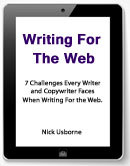Nick Usborne's Blog, page 14
February 17, 2017
Michele asks me for a clearer definition of clickbait when writing headlines.
(What follows are the notes I wrote in advance of recording the video. They’re my talking points. Not a regular post or article. Just notes.)
My recent videos have all been related to my course, Conversational Copywriting.
This one comes from a question asked by Michele Reder, who took an earlier course of mine, How to Write Better Headlines.
That said… as you’ll see… her question and my answer do bring us back to the topic of conversational copywriting.
So…
In one of the exercises in my headline course I ask students to rewrite a headline for a page of web content.
Here’s what I give them.
“People who seem to age really well have these 4 things in common.”
Michele came back with…
“4 Traits of Youthful Adults”
Certainly shorter and snappier than my original. Maybe a little too short.
Then she asked about a slightly longer version she was working with…
“4 Traits of Youthful Adults – How Many of These Do You Share?”
I think this longer version is stronger. Because by asking a question it draws the reader into the body of the article.
But her concern was that maybe she had crossed the line and that her headline was now clickbait.
I told her not to worry abut that. Clickbait, I said, is when you write a headline that makes a big promise that the body of the page fails to deliver. Or dramatically misleads the reader in some way.
For example, the title of a YouTube video I saw a while back said something like. “OMG… my wife just walked out on me!”
Not true. As the video revealed, she simply went out for the evening with some girlfriends, leaving him at home with the kids.
That’s clickbait. Totally misleading, just to get me to watch the video.
Then Michele pointed out that in my headline course I actually had a second definition of clickbait… which is the one she was concerned about.
This is where I talked about headline approaches that just go over the top in some way.
Let’s look at Michele’s headline again: “4 Traits of Youthful Adults – How Many of These Do You Share?”
Now let’s change that a bit and say: “4 Traits of Youthful Adults – Number 4 will make your jaw drop!”
I think her one is fine. I think the second one is clickbait.
It’s not lying or deliberately misleading, but those draw-dropping claims are almost always huge exaggerations.
And now… connecting back to conversational copywriting.
Her version is conversational. She’s just asking, “How many of these do you share?”
The jaw-dropping version is not conversational, because real people just don’t talk to each other like that.
And maybe that’s how you make those decisions about your content headlines if you’re concerned about crossing the clickbait line….
Just ask yourself, “Would I say this in conversation?”
Michele, many thanks for the question!
NOTE: I have an entire course devoted to the craft of Conversational Copywriting. Find out more about it here… And another course all about writing better headlines for web content, email and social media.

If you found this post helpful, sign up for my e-newsletter and get a free copy of my 35-page guide…
Writing For The Web #1 — 7 Challenges every Writer and Copywriter faces when writing for the Web.
Sign up and I’ll send you the link for the download, and then you’ll receive my most recent post as part of my e-newsletter every Tuesday morning.
Sign Up for my Excess Voice Newsletter…
Name:
Email:
0 subscribers
We respect your privacy
Email Marketing by GetResponse
(Your email address will be used only for the purpose of sending you this newsletter, and you’ll be free to unsubscribe at any time.)
The post Michele asks me for a clearer definition of clickbait when writing headlines. appeared first on Writing for the web - online copywriting and content writing..
February 15, 2017
Traditional versus conversational copywriting. One guy thinks traditional wins.
(What follows is the outline I wrote for myself in advance of recording the video. This is just an outline. Not a regular post or article.)
A while back I was sent a bit of a challenge by a reader who didn’t agree with much of what I have been writing about the thrust of my course, Conversational Copywriting.
Fair enough.
Here’s what he wrote… slightly edited for brevity…
“I disagree with your claim that traditional copywriting is dead. I think traditional copywriting works just fine. I work in direct response and the tried and trusted approaches to selling are timeless… both in print and on the web.”
Well… I’m going to agree and disagree with him on this.
A bit of history. My own background is in offline direct response. In the days before the web I wrote direct mail for over 15 years. I know how it works.
And yes, there are still a few industry verticals in which hard-core direct response sales copy works. That’s absolutely true.
Investment newsletters.
Alternative healthcare information and membership sites.
Income opportunity products and courses.
Prepper and survivalist products and services
And a few others…
For products and services like these, the old-school direct response works fine. It really does. Even online.
But the vast majority of businesses in the US, North America and the rest of the world do not fall into those narrow industry verticals.
Even within those verticals, there is a demographics squeeze.
Traditional direct response can work well against the Boomer generation. But not nearly as well against Millennials and younger.
It’s a dying approach that targets an aging audience.
Also… some forward-thinking marketers are showing how you can tackle those same verticals in a more conversational way.
In my course I mention Jeff Walker, who has done an amazing job of turning the old-school, long-form sales letter on its side. Go to his site, ProductLaunchFormula.com. Sign up for his email list. I’m not telling you to buy his product. But just to experience his sales process is an education in itself.
And yes, the way I see it, Jeff if definitely conversational in his approach. He’s a master at it.
Old-school versus conversational is a debate that will likely go on for a long time.
But as you can tell, I’m pretty clear about where I stand on this.
Do you have a question for me? If so, add it in the comment box below.
NOTE: I have an entire course devoted to the craft of Conversational Copywriting. Find out more about it here…

If you found this post helpful, sign up for my e-newsletter and get a free copy of my 35-page guide…
Writing For The Web #1 — 7 Challenges every Writer and Copywriter faces when writing for the Web.
Sign up and I’ll send you the link for the download, and then you’ll receive my most recent post as part of my e-newsletter every Tuesday morning.
Sign Up for my Excess Voice Newsletter…
Name:
Email:
0 subscribers
We respect your privacy
Email Marketing by GetResponse
(Your email address will be used only for the purpose of sending you this newsletter, and you’ll be free to unsubscribe at any time.)
The post Traditional versus conversational copywriting. One guy thinks traditional wins. appeared first on Writing for the web - online copywriting and content writing..
February 14, 2017
Start new conversations by inviting your visitors to ask questions.
(What follows are the notes I wrote in advance of recording the video. They’re my talking points. Not a regular post or article. Just notes.)
This isn’t one of my Q&A videos.
Nobody asked me this question.
So I’ll ask it myself.
“What do I think is the most powerful way to get conversational with a website’s audience?”
In my course, Conversational Copywriting, I talk about a few different ways to get your clients started.
But if I had to choose one, and only one way… it would be this…
Invite your readers to ask you questions.
Do that and a few very powerful things happen.
Answer those questions and you have automatically started a series of conversations. Include a comment function on those Q&A pages, and that conversation can spread to include more and more people.
A study of the questions asked gives you incredible insights into what truly interests your audience. (It’s probably not what you think.) You can now adjust your inbound marketing efforts accordingly.
Those questions, and the answers you and your team write, will teach you how to write in a conversational manner. You can now take that approach and tone of voice, and apply it across other platforms, like your blog and social media.
Am I making this up and I go along?
Absolutely not.
Inbound marketing expert Marcus Sheridan has written an entire book on this topic. It’s called They Ask You Answer.
For myself, generating conversations with an audience is the secret to the success of my own website about coffee, CoffeeDetective.com.
Coffee Detective is a side project of mine. Four or five thousand people come to the site each day. That’s enough traffic for me to treat the site as my private test bed for all things related to web content.
The site truly took off only when I created a page which invited visitors to ask me questions about making coffee at home. I added that invitation page about 6 years ago now.
Today over half of my visitors come to the site to find answers to the hundreds of questions I have now answered.
That emphasis on Q&A has informed what I write about, how I write it, and how I choose to interact on various platforms, including social media.
Invite your readers to submit questions, answer them well, and learn from the process.
In that spirit… if you have a question about conversational copywriting, please ask it in the comments section below.
NOTE: I have an entire course devoted to the craft of Conversational Copywriting. Find out more about it here…

If you found this post helpful, sign up for my e-newsletter and get a free copy of my 35-page guide…
Writing For The Web #1 — 7 Challenges every Writer and Copywriter faces when writing for the Web.
Sign up and I’ll send you the link for the download, and then you’ll receive my most recent post as part of my e-newsletter every Tuesday morning.
Sign Up for my Excess Voice Newsletter…
Name:
Email:
0 subscribers
We respect your privacy
Email Marketing by GetResponse
(Your email address will be used only for the purpose of sending you this newsletter, and you’ll be free to unsubscribe at any time.)
The post Start new conversations by inviting your visitors to ask questions. appeared first on Writing for the web - online copywriting and content writing..
February 10, 2017
How to introduce your clients to Conversational Copywriting.
This question is from Stacey H., who has taken my course, Conversational Copywriting.
Instead of simply replying to the Stacey’s message one-on-one, I decided to share both her question and my answer with this short video.
(What you see below are the notes I wrote in advance of recording the video. They’re my talking points.)
First, Stacey’s full question:
“Nick, I just completed your Conversational Copywriting course and I love it. It feels so right to me! And I have one client who I think could be open to this. But how do I introduce the idea to them? How can I get my clients to be conversational?”
Thanks for the question Stacey.
OK… maybe more than one question to unwrap there.
You say, “I have one client who I think could be open to this…”
That’s an important point.
Not every client is going to thank you for talking about this.
A lot of companies are still wedded to a more traditional, broadcast approach to advertising and copywriting.
You probably don’t want to waste too much time trying to persuade them to change their ways.
But if… as a you suggest… you have an existing or potential client who you think might be open to the idea… take a look at two things.
First… are they active on social media? Are they doing it reasonably well? Are they being responsive, answering questions? If so, they are already being conversational.
Just help them take that kind of language and mindset into other areas of promotional activity.
Second… are they sharing stories?
Founder stories, customer stories, employee stories… any kinds of stories?
Sharing stories is a very personal and engaging way to communicate.
Storytelling is just one step removed from full conversation.
Invite customers to send in more stories.
That’s how I’d start.
Find places – like social media or storytelling – where they are already being conversational… even if only a little bit… and then expand on that… take it into their content marketing, emails, e-newsletters etc.
Start replacing some of that one-way, broadcast style writing with more conversational writing.
And once you have done that for one client, you can use that as a case study to show other clients and prospects.
I hope that helps a little.
NOTE: I have an entire course devoted to the craft of Conversational Copywriting. Find out more about it here…

If you found this post helpful, sign up for my e-newsletter and get a free copy of my 35-page guide…
Writing For The Web #1 — 7 Challenges every Writer and Copywriter faces when writing for the Web.
Sign up and I’ll send you the link for the download, and then you’ll receive my most recent post as part of my e-newsletter every Tuesday morning.
Sign Up for my Excess Voice Newsletter…
Name:
Email:
0 subscribers
We respect your privacy
Email Marketing by GetResponse
(Your email address will be used only for the purpose of sending you this newsletter, and you’ll be free to unsubscribe at any time.)
The post How to introduce your clients to Conversational Copywriting. appeared first on Writing for the web - online copywriting and content writing..
February 8, 2017
With conversational copywriting you communicate like a real person, not a corporation or marketer.
This question is from Daniel P., who has been reading about my course, Conversational Copywriting.
Instead of simply replying to the email Dan sent me, I decided to share both his question and my answer with this short video.
(What you see below are the notes I wrote in advance of recording the video. They’re my talking points.)
First, Dan’s question:
“You talk about being conversational with our copywriting. I get that when we’re actually in conversation with someone… like in the comment stream under a blog post, or when going back and forth on social media. But how can we be conversational when writing a page of content or even a sales page?”
Good question.
It’s about the tone and language you use.
As an example… and I grabbed this from a website just before recording this…
It’s from a company that specialises in leasing vehicles for companies.
One of the things they offer:
“Multiple channels and dedicated personal staff to handle your vehicle remarketing needs.”
A more conversational approach would be:
“When you done with a vehicle, we can help you sell it.”
Another example:
“Download the National Car Rental app and tap into the power of more speed, choice and convenience – all at your fingertips.’
And the conversational version…
“Download the National Car Rental app for when you’re away from your desk.”
Short words, simple concepts. It’s how you’d talk about it over lunch, not how you’d write it up in a business report.
The real difference… in their versions the relationship is with a corporation or marketing group that talks funny.
In my versions… the relationship is with real people who communicate in natural, everyday language.
Who are you going to trust more… a company or a person?
I hope that answers your question.
NOTE: I now have an entire course devoted to the craft of Conversational Copywriting. Find out more about it here…

If you found this post helpful, sign up for my e-newsletter and get a free copy of my 35-page guide…
Writing For The Web #1 — 7 Challenges every Writer and Copywriter faces when writing for the Web.
Sign up and I’ll send you the link for the download, and then you’ll receive my most recent post as part of my e-newsletter every Tuesday morning.
Sign Up for my Excess Voice Newsletter…
Name:
Email:
0 subscribers
We respect your privacy
Email Marketing by GetResponse
(Your email address will be used only for the purpose of sending you this newsletter, and you’ll be free to unsubscribe at any time.)
The post With conversational copywriting you communicate like a real person, not a corporation or marketer. appeared first on Writing for the web - online copywriting and content writing..
February 7, 2017
Conversational copywriting is about removing the layer of mistrust between a company and its customers.

When you walk into a car dealership and a sales person walks towards you, you can feel a change take place in your body.
There’s some kind of chemical adjustment happening in your brain. You feel a sudden tension in your muscles. Not relaxed at all.
You feel ready to fight. Or at least, to negotiate.
This is a little weird. It’s not like you’re walking down a dark alley at night, twitching at every sound, preparing to fight or run for your life.
But the symptoms are the same, even if not quite as elevated.
How come?
It’s because you don’t trust the sales person. You fear he or she is about to take advantage of you. They’re going to throw their best sales pitch at you, and you’re fearful that it might work.
Although something of a cliché, the relationship between the car salesman and his or her prospect serves to demonstrate the layer of mistrust that exists between almost any company and its customers.
We feel that same resistance when we see an ad that promises to help us lose 30 lbs in 30 days. Or master the art of investing and become wealthy. Or to find true love with a few clicks of the mouse.
Even when we are exposed to ads and promotions that take a more credible path, we still feel cautious.
And we always will feel that way for as long as advertising and copywriting take an adversarial position. Them against us.
Adversarial? Pretty much. That’s the default setting for most traditional, broadcast advertising. Particularly when you want people to do something.
If your ad is just about branding, that’s different. Happy people, cute puppies and ponies, blue skies and a beach or a smiling grandma will generally do the trick.
But if you are trying to drive a sale, offline or online, that’s different. That’s when it becomes adversarial.
It’s adversarial because it’s the advertiser against the prospect.
The prospect has her filters up, and is on full alert, not trusting the company at all. The company, knowing this, is using every trick in the book to break down the prospect’s defenses – to overcome her “objections” – and make her reach for her credit card.
Like I said, adversarial.
In the olden days, the days dominated by one-way, broadcast media, like TV, radio and bill boards, this approach worked OK. Hammer away for long enough and you’ll break down those defenses.
Online? Not so much.
Online is not a one-way medium. It’s a two-way medium. This means people get to talk back. They get to talk about your business as well. They can share with their friends when you do or say stuff they don’t like.
Companies have lost the “one-way medium advantage”.
This is why it’s time to retire the traditional, one-way and adversarial approach to selling.
It’s time to take the conversational approach. In other words, instead of selling “at” your prospects, get into conversation “with” them.
Do that and the defenses fall away. They are no loner needed.
Engage with your audience with openness and honesty and people will not only lower their defenses, but they grow to trust you.
And when they trust you, you can make that sale with the lightest of touches.
No more fight, flight and adversarial positions.
Just conversation, trust, loyalty and a powerful long-term relationship with every buyer.
That’s the power of conversational marketing and copywriting.
NOTE: I now have an entire course devoted to the craft of Conversational Copywriting. Find out more about it here…

If you found this post helpful, sign up for my e-newsletter and get a free copy of my 35-page guide…
Writing For The Web #1 — 7 Challenges every Writer and Copywriter faces when writing for the Web.
Sign up and I’ll send you the link for the download, and then you’ll receive my most recent post as part of my e-newsletter every Tuesday morning.
Sign Up for my Excess Voice Newsletter…
Name:
Email:
0 subscribers
We respect your privacy
Email Marketing by GetResponse
(Your email address will be used only for the purpose of sending you this newsletter, and you’ll be free to unsubscribe at any time.)
The post Conversational copywriting is about removing the layer of mistrust between a company and its customers. appeared first on Writing for the web - online copywriting and content writing..
February 3, 2017
The rise of ad blockers is a warning about the future of selling online.

According to a recent report from PageFair, the use of ad blockers grew by 30% in 2016 alone.
By the end of 2016, there were over 615 million devices with ad blockers installed worldwide. 62% of those devices were mobile.
A couple of years ago it was only the nerds who were blocking ads. Now it’s gone mainstream. And it’s not just younger people who are doing this. The spread across age groups is surprisingly even.
This spells big trouble for both advertisers and the media sites that carry their ads.
The advertisers sense, quite rightly, that their ads are being viewed by fewer and fewer people.
And the websites that carry advertising as a core part of their revenue stream are facing an uncertain future.
So what’s happening here? Why the sudden surge in the use of ad blockers?
It’s really not so hard to figure out.
Ads are intrusive and annoying for the most part. For generations, in the offline world, we have accepted them as a necessary evil. Buy a magazine, and expect tons of glossy ads. Turn on your TV and expect your favorite shows to be interrupted by commercials.
When you don’t have a choice, you accept these things.
But when you DO have a choice, and when that choice is as simple as installing an ad blocking extension or app to your computer or phone… well, why not?
Why subject yourself to all those ads if you can avoid them?
Marketers are slowly finding alternatives to the traditional ad formats that are now being blocked.
Companies are getting the word out there by sponsoring content. Sponsored content gives them the exposure and goodwill they’re looking for, without being blocked.
Another way companies are reaching out is through social media influencers. If you have a large and growing following on one or more social media channels, it won’t be long before you’re approached by a company or its PR agency. They’ll be looking for ways to get their message out through your posts and updates.
Again, they get the exposure they want, without being blocked.
Over time marketers will find more and more alternatives to reaching their audiences online.
But there is more to be concerned about if you’re selling online.
This isn’t just about the ads.
People aren’t blocking ads because there’s something inherently bad about them.
They block ads for the same reason you try to avoid that neighbor who keeps trying to sign you up for his multi-level marketing team.
It’s not just about the ads, it’s about the language and attitude of the ads.
Mostly it’s about the language.
Because most copywriting – if we’re completely honest about it – is a little pushy and a tad manipulative.
Don’t feel offended. I do the same as a copywriter. It’s part of what makes traditional copywriting work so well.
When I deliberately tweak my message to touch a reader emotionally… when I talk about savings, scarcity and limited time offers… I’m being manipulative. It goes with the job description.
But the rise of ad blockers is a warning signal.
It’s reminding us that in the online world people have options and choices that weren’t available to them with offline media.
They can tune us out and turn us off.
And this means we need to start changing the way we talk to our readers when we write ads, emails and sales page.
Our readers have a sensitivity to promotional language they didn’t have offline. Or if they did, they didn’t have the means to respond or opt out.
Hence the need to move over to conversational copywriting.
Going forward you should depend less on traditional, promotional copywriting when selling online. Because you’re going to get ignored or even blocked.
Focus more on conversational copywriting, which is more in tune with the online environment and isn’t going to offend or upset anyone.
To better understand what I mean by conversational copywriting, its history and its future… check out my previous post, “My 19-year romance with conversational copywriting explained”.
That should serve as a good primer on this topic.
Also… within the next 10 days or so I’ll be publishing a short course on Conversational Copywriting. If you’ll like to be notified when it goes live, please send me a quick note through my Contact page, and include the phrase “Conversations Happen Here” in the first line of the message.

If you found this post helpful, sign up for my e-newsletter and get a free copy of my 35-page guide…
Writing For The Web #1 — 7 Challenges every Writer and Copywriter faces when writing for the Web.
Sign up and I’ll send you the link for the download, and then you’ll receive my most recent post as part of my e-newsletter every Tuesday morning.
Sign Up for my Excess Voice Newsletter…
Name:
Email:
0 subscribers
We respect your privacy
Email Marketing by GetResponse
(Your email address will be used only for the purpose of sending you this newsletter, and you’ll be free to unsubscribe at any time.)
The post The rise of ad blockers is a warning about the future of selling online. appeared first on Writing for the web - online copywriting and content writing..
January 27, 2017
My 19-year romance with conversational copywriting explained.

I’m going to be writing quite a bit about conversational copywriting over the next few weeks.
So I thought it might be a good idea to first define what I mean, and give the term a little history and context.
I first began writing and talking about conversational copywriting way back in the late 1990s. In 1998 to be exact. Hence the 19-year romance.
I made the simple point that as the web is a two-way communications medium, shouldn’t we adjust our marketing and promotional language accordingly?
Traditional media, like TV, are one way. The advertiser gets to speak at you, but you can’t talk back to the advertiser through your TV.
The language of advertising developed accordingly. Advertising spoke at you, through TV, radio, magazine ads, bill boards and so on.
Then along came the web… a two-way communications medium. Huge change.
The web is the first mass medium that gives equal access to the users – the recipients of advertising.
My argument, back in the late 90s, was that this deep and profound difference in the nature of the web as a communications medium should impact the kind of language companies used on their websites and in their ads and promotions.
They should no longer be broadcasting at their audience but should, instead, use language that invites two-way communications.
In other words, they should get into conversation with their prospects and customers.
They should use conversational language.
The need for this kind of shift seemed self-evident to me. A few of my clients agreed, and we adjusted the way they conversed with their audiences accordingly.
But for the most part, nothing much happened.
Advertisers simply used the web as a new and relatively inexpensive broadcast medium.
2001 saw the publication of The Cluetrain Manifesto. A wonderful book, way ahead of its time in many ways. And the core of their message was this: Markets are conversations.
The authors were beating the same drum as me. Except they dug deeper, had a lot more to say, and reached a lot more people.
Did that book have a transformative effect on the language advertisers used online? I don’t think so. Some, but not much.
In 2007 Joseph Jaffe’s book, Join the Conversation, was published. Beating the same drum again. Joseph wrote a series of books, all well received and influential.
Did his books change the world of online advertising? Did companies move in droves from broadcast mode to conversational mode? Not really.
Conversations Happen Here!
At about the same time, social media became a big thing.
If there is anything online that has a huge neon sign with a flashing arrow pointing to the message, ”Conversations Happen Here”, it’s social media.
Surely social media would finally force companies into the realm of conversational marketing and copywriting.
Apparently not.
Most companies use social media as one more broadcast medium, promoting their stuff in the same, tired, one-way promotional language.
So what’s going on here?
For mainstream advertisers, I think there are two things at play here, both of which are holding back the rise of conversational copywriting.
First, being conversational is seen as more time-consuming. It’s easier, faster and less expensive for companies to stick with “business as usual” and keep pumping out their one-way promotions.
What they don’t factor in is the massive upside of going conversational. The benefits include a big increase in engagement, way higher levels of trust, better conversions to sales and increased customer loyalty.
Sounds good, right? But for some reasons, most companies can’t be bothered to put in the time to make it work.
Second, it’s easier to measure outcomes with traditional advertising. It’s much easier to vacuum up huge amounts of data drawn from ad impressions, clickthroughs, conversions and so on.
Much harder to do the same for conversational copywriting and marketing.
Should you ignore something good just because it’s harder to measure? Of course not!
After all this time, I still have a thing for conversational copywriting.
I’m still a fan. The romance continues.
And when I see companies ignoring the true, conversational nature of the web as a medium, and soldiering on with their old-school, one-way writing and copywriting styles, I just smile.
I smile because I know they’re missing something big.
I know that as the social web expands its influence, conversational copywriting will become more and more important.
And I know that smaller, smarter and nimbler companies will achieve new levels of success by taking the conversational approach.
There is a ton to say about all this…
Over the weeks to come I’ll be digging deeper into the craft of writing conversational copy.
I’ll be showing you what is, how to use and it and why it works.
And I’ll be demonstrating how this kind of writing can become a true superpower for small business owners, entrepreneurs and even freelancers, whatever the industry they work in.
Please stay tuned!
Also… within a couple of weeks I’ll be publishing a short course on Conversational Copywriting. If you’ll like to be notified when it goes live, please send me a quick note through my Contact page, and include the phrase “Conversations Happen Here” in the first line of the message.

If you found this post helpful, sign up for my e-newsletter and get a free copy of my 35-page guide…
Writing For The Web #1 — 7 Challenges every Writer and Copywriter faces when writing for the Web.
Sign up and I’ll send you the link for the download, and then you’ll receive my most recent post as part of my e-newsletter every Tuesday morning.
Sign Up for my Excess Voice Newsletter…
Name:
Email:
0 subscribers
We respect your privacy
Email Marketing by GetResponse
(Your email address will be used only for the purpose of sending you this newsletter, and you’ll be free to unsubscribe at any time.)
The post My 19-year romance with conversational copywriting explained. appeared first on Writing for the web - online copywriting and content writing..
January 22, 2017
For a me-too business, stories can be the great differentiator.

I have this dream.
My new client has a product or service with an amazing point of difference.
There is something unique about it. It has something none of its competitors possess. It’s amazing. It’s incredible.
Oh joy!
And then I wake up.
It’s incredibly rare that we have the opportunity to work on promoting a product or service that is significantly different from its competitors.
Mostly we have to work with very minor points of difference. Sometimes there is no point of difference at all.
This doesn’t mean our clients have poor products or lack imagination.
It’s just the way things are.
Look at the offerings of a dozen small bookkeeping firms, and they’ll all be pretty much the same.
The same goes for dentists, plumbers, florists, roofers and the makers of fastenings for commercial trucks and trailers.
So what can you do?
One answer was brought to me by fellow freelancer Liz Farr of Farr Communications.
Her clients are accountants.
She knows that all her clients offer pretty much the same services. So she sends each new client a short questionnaire before she starts work.
I won’t give away the full recipe to her secret to doing great work.
But, with her permission, here is her question number three…
“Do you have samples of how you have gone above and beyond the expected to serve a client?”
What’s she doing here?
She’s saying, “Tell me a story!”
While the list of services offered is pretty much the same across accountancy firms, the stories they can tell are very different.
Part of Liz’s secret to being able to do great work for her clients is that, unlike most of her competitors, she has found a way to make every client unique. She makes them different. She makes them shine, pop out and look good.
And she does it all with stories.
Best of all, she gets the client to do the heavy lifting for her. She doesn’t have to become a hybrid copywriter / investigative reporter and go digging for stories.
She just asks.
And once a client gives her a few stories to work with, she can find the one that works best and weave it into her work for them.
Stories not only differentiate companies that would otherwise sound the same, but they also humanize companies that can be perceived to be a tad impersonal… like an office full of accountants.
Tell a story and you create an instant point of differentiation. At the same time, you also put a very human face to the entire company.
A double win.
Try this with your own clients. Particularly if you have me-too clients with few or no points of difference to talk about.
Ask them for stories.
And if it works, be sure to send Liz a note of thanks!
NOTE: If you’d like to use the power of storytelling to increase your skills as a web content writer, online copywriter or social media writer, take my course… Selling With Stories…

If you found this post helpful, sign up for my e-newsletter and get a free copy of my 35-page guide…
Writing For The Web #1 — 7 Challenges every Writer and Copywriter faces when writing for the Web.
Sign up and I’ll send you the link for the download, and then you’ll receive my most recent post as part of my e-newsletter every Tuesday morning.
Sign Up for my Excess Voice Newsletter…
Name:
Email:
0 subscribers
We respect your privacy
Email Marketing by GetResponse
(Your email address will be used only for the purpose of sending you this newsletter, and you’ll be free to unsubscribe at any time.)
The post For a me-too business, stories can be the great differentiator. appeared first on Writing for the web - online copywriting and content writing..
January 16, 2017
It’s not always easy being upbeat on demand. It may even feel a little fake. But…

Whether I’m speaking on a stage, giving a live webinar or producing video-based training materials, I often encounter the same criticism…
“Nick, you don’t sound upbeat enough!”
And here’s a quote from a review for one of my courses:
“Lots of good stuff worth thinking about. I did find Nicks voice a bit ‘sleep inducing’ but otherwise clear. Thanks.”
Ouch. That’s not good. Feedback like that I take seriously.
In fact, before recording a lesson or lecture, I usually go through a series of physical, voice and mental exercises… all designed to give me a little more of an upbeat feel when I speak.
So yes, I get it. I understand why people want to feel some enthusiasm and positive energy from someone they turn to as a teacher or mentor.
I think we are all drawn to that kind of positivity.
On the other hand, I sometimes have less charitable thoughts that go along the lines of, “Really? You need me to entertain you as well as teach you? You need me to make you feel good and special while you learn? What is this… kindergarten?”
As you can see, my internal monologue on this topic tends to get a little out of hand.
I try not to think in those terms too often, because I really do understand. I know I’m no different. I look for positive energy from the people I learn from too.
Anyway, it seems I’m not alone in sometimes complaining about the expectation that I should always sound upbeat, happy and positive all the time while “On Air”.
In a recent vlog, titled “I’m not that happy”, Casey Neistat talked about the pressure on YouTubers to always sound upbeat and positive when recording their videos. He mentions how hard it was being upbeat on his vlog on the day of his father-in-law’s funeral.
Neistat knows a thing or two about what it takes to attract and retain an audience on YouTube, because he has over 6.2 million subscribers.
He was inspired to talk about his feelings on the subject because a fellow vlogger had just done the same. PewDiePie talks in this video about how he’s not naturally nearly as upbeat as he appears in his vlog, and that he’s not a fan of “forced positivity”.
Who cares what a guy called “PewDiePie” thinks? Well… think on this. His YouTube channel has over 50 million subscribers.
To put that in perspective, the New York Times digital edition has 1.6 million subscribers.
Both these guys know a heck of a lot about giving viewers what they want.
And while they may occasionally complain about having to appear happier, more upbeat and more positive than they’re actually feeling… I’m pretty sure they have no doubt that their positivity is central to their success.
That’s why one of my own new year resolutions is to listen more carefully to people who find me a little too quiet and not upbeat enough.
It’s time for me to stop whining and recognize that if being upbeat and positive helps people learn, then it should be central to the value I offer in my courses, calls and webinars.
This is important for you too…
Every time you get on the phone with a client, prospect, supplier or colleague, the level of positivity you express makes a difference.
The same is true when you write an email, or sit down to work on your next project.
How you feel will seep into your writing.
If you are feeling down, it’s almost impossible to avoid that finding some expression in your work. If you are feeling positive, that is expressed too.
Whether you’re PewDiePie with 50 million subscribers, or you’re just starting out as a freelancer, you need to be able to turn on that “positivity” tap, even when you don’t feel like it.
It’s not always easy. But it’s necessary.
Related:
Not many people know this about me, but I use Positive Affirmations on a near daily basis. I find it helps me move into the day with more of a “can-do” attitude. I wrote a short e-book about it… Affirmations for Freelancers.

If you found this post helpful, sign up for my e-newsletter and get a free copy of my 35-page guide…
Writing For The Web #1 — 7 Challenges every Writer and Copywriter faces when writing for the Web.
Sign up and I’ll send you the link for the download, and then you’ll receive my most recent post as part of my e-newsletter every Tuesday morning.
Sign Up for my Excess Voice Newsletter…
Name:
Email:
0 subscribers
We respect your privacy
Email Marketing by GetResponse
(Your email address will be used only for the purpose of sending you this newsletter, and you’ll be free to unsubscribe at any time.)
The post It’s not always easy being upbeat on demand. It may even feel a little fake. But… appeared first on Writing for the web - online copywriting and content writing..
Nick Usborne's Blog
- Nick Usborne's profile
- 6 followers





